Apple iPhone 4S: Thoroughly Reviewed
by Anand Lal Shimpi & Brian Klug on October 31, 2011 7:45 PM EST- Posted in
- Smartphones
- Apple
- Mobile
- iPhone
- iPhone 4S
Improved Baseband - No Deathgrip
We’ve mentioned already that the 4S is more of an evolution of the CDMA iPhone 4 than the GSM/UMTS iPhone 4, and where that’s most obvious is again is its cellular architecture. When we reviewed the GSM/UMTS iPhone 4, we investigated and explained why its design made it especially prone to unintended attenuation when held a certain way. Apple remedied the situation somewhat by giving away free cases, but only in the case of the CDMA iPhone 4 was the fundamental design issue remedied by adding receive diversity with a second cellular antenna at the top.
The 4S builds on this architecture by incorporating the same diverse receive path with two U shaped antennas at top and bottom, and adding transmit diversity to the equation. I’m being a bit fast and loose with the term “diversity” here, since the 4S cannot transmit simultaneously on both antennas, but rather switches between the two antennas based on which has the least receive fading. Receive diversity is a bit more interesting to explain, since the 4S appears to be able to dynamically decide whether to select one of the two receive paths (in the case that one is much more faded than the other), or combine the two (using something like maximal-ratio combining) and get a better quality equivalent signal.
When I talked about the CDMA 4’s receive diversity scheme, I went into detail to prove that this feature was present. With the 4S, these diversity features are much easier to talk about because Apple has been directly forthcoming about the feature this time. In addition, the transmit switching part of the equation is discussed at length in Apple’s FCC disclosure (since the FCC is interested in scrutinizing transmitters), and even includes a nice diagram.
The device is capable of switching between the Primary/ANT1 and Secondary/ANT2 Antennas. The antenna switching is implemented with a physical, "break-before-make" switch such that only one antenna can be used for cellular transmission at a time.
To re-state the evolution that Apple has taken with this design, the GSM/UMTS 4 had one transmit and receive chain, the CDMA 4 added a second receive chain for diversity, and the 4S now has two receive chains and the ability to switch between two transmit chains. The result is that the phone no longer is prone to fading on either the forward or reverse link due to being held near the feed points for one chain.
To be totally thorough, you can immediately see that the 4S still incorporates the same overall design however, complete with a a U.FL connector at the bottom and a feed cable that runs up the side of the PCB to the top. From here it obviously terminates somewhere that makes contact with the top antenna.

Encircled in red: Top antenna feed cable (Original photo courtesy iFixit)
When we saw that the CDMA iPhone used Qualcomm’s MDM6600, we made an educated guess that the next device would likely be based on the same baseband. It turned out that this was pretty close to the case, as the iPhone 4S uses an unannounced Qualcomm MDM6610.
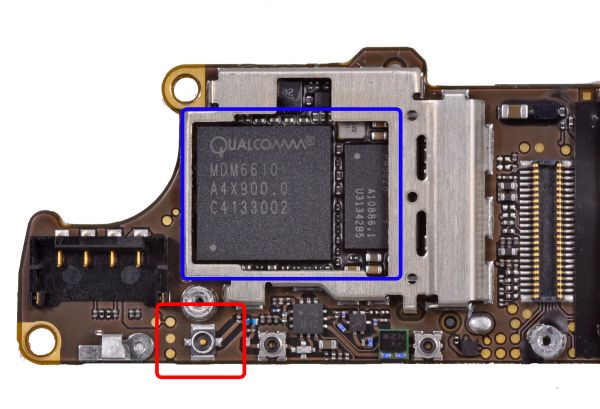
Encircled in blue: Qualcomm MDM6610 and PM8028, Red: Bottom antenna U.FL connector. Note to the right the two test pads for the two chains. (Original photo courtesy iFixit)
There are some immediate differences that stick out about MDM6610 versus MDM6600. First, 6610 doesn’t appear to include an internal transceiver, unlike MDM6600 which previously included a transceiver in its package. MDM6610’s package is correspondingly smaller, at 10x10 mm, compared to 6600’s 9.8x12.2 mm, but again you have to factor in the fact that the transceiver isn’t inside that package anymore. Based on those facts and the state of 28nm maturity, it’s almost certain that MDM6610 is still a 45nm part. The 4S uses Qualcomm’s RTR8605 IntelliCeiver transceiver for cellular RF management and also for GLONASS/GPS. We’ve seen RTR8600 before, and RTR8605 appears to just be an improvement upon that part with the same functionality. In fact, inside the MDM6610’s AMSS it’s just referred to as RTR8600.
Qualcomm isn’t ready to talk at all about MDM6610, but I’ve done a little digging and know more about this part. First off, it’s referred to as codename “Trek” inside the Qualcomm AMSS (Advanced Mobile Subscriber Software), whereas MDM6600 in the CDMA iPhone was referred to as “Phoenix.” When we first saw that the 4S was using a baseband that hasn’t been announced, we assumed it was an Apple specific one-off. However, after some digging I uncovered a reference to a GSM/UMTS only part as well: “MDM6210MDM6610”. For those that aren’t familiar, the 2 connotes GSM/UMTS compatibility, 6 adds 1x/EVDO. Apple appears to have secured MDM6610 exclusivity for the time being, but I expect we’ll see a more formal announcement of the MDM6x10 family down the road. This is pretty much par for the course for Apple when it comes to component sourcing.
| iPhone 4S - Network Support | |||||
| GSM/EDGE Support | 850 / 900 / 1800 / 1900 MHz | ||||
| UMTS/HSDPA/HSUPA Support | 850 / 900 / 1900 / 2100 MHz | ||||
| HSDPA/HSUPA Speeds | 14.4 Mbps / 5.76 Mbps | ||||
| CDMA2000 1x/EVDO Support | EVDO Rev.A (800 / 1900 MHz) | ||||
| Baseband Hardware | Qualcomm MDM6610 | ||||
MDM6610 also appears to inherit all the air interfaces that MDM6600 had, including WCDMA/HSPA+ with HSDPA 14.4, HSUPA 5.76, GSM, CDMA 1x/EVDO (up to Rev.B, though Apple notes only A is used at present), and finally GPS/GLONASS. Superficially, there don’t appear to be any major differences beyond using an external transceiver to accommodate diversity and transmit switching. In addition, the 4S contains all the same bands as the GSM/UMTS iPhone 4.
I was initially worried that Apple would go the same route that it did with both iPhone 4 launches and initially not include FieldTest. Thankfully, the 4S includes FieldTest right out of launch, which works for both CDMA and GSM/UMTS provisioned 4Ses.

iPhone 4S Field Test under CDMA Mode
There’s a corresponding difference in the interface for the two modes. On CDMA iPhone 4S mode, there are tabs for 1x and EVDO, and Rx signal strength fields for both receive paths, as well as the current transmit power. What’s interesting here is that when using the 4S in CDMA mode, you can see the receive strength change for each antenna when held.
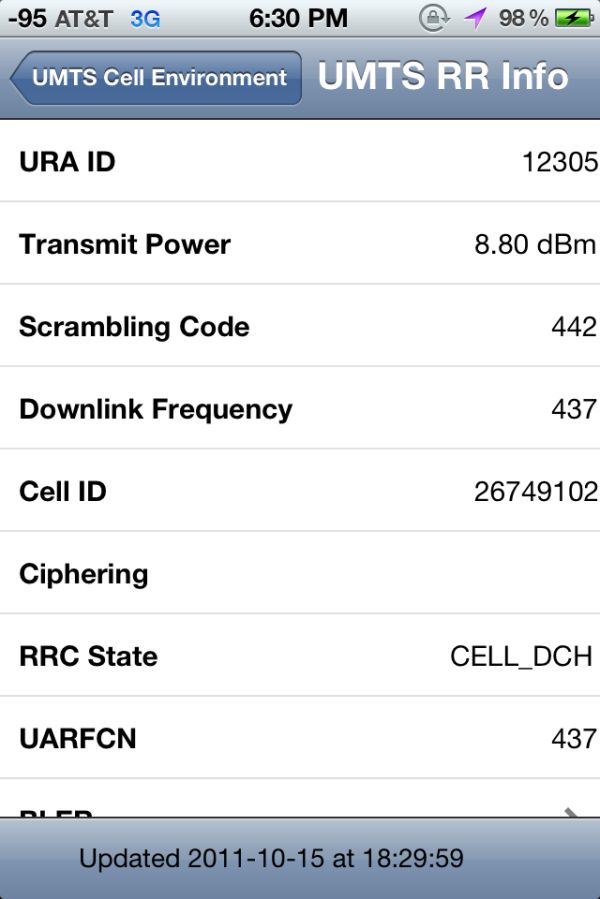
iPhone 4S Field Test under UMTS/GSM Mode
On the GSM/UMTS provisioned iPhone 4S, you don’t get individual receive strength for each chain, instead just the effective RSCP from either the selected chain or combined. If you grip the phone while watching this, you can sometimes watch RSCP race to –130 dBm and then switch entirely to the other antenna and race back up to an acceptable number. As a reminder, to get into FieldTest dial *3001#12345#* - you can then keep numerics instead of bars in the top left by force quitting FieldTest after launching it (hold down power/lock until power off appears, then hold the home button).
So how does the 4S do in our actual attenuation testing? Very well actually. I watched the RSCP of one NodeB and held the 4S all the same ways we’ve done since the 4, recorded a bunch of data, and averaged it together. What we’re measuring here is reported in dBm, and less attenuation is better (0 dBm = 1 mW).
| Signal Attenuation Comparison in dB - Lower is Better | ||||||||
| Cupping Tightly | Holding Naturally | Holding in Case | On an Open Palm | |||||
| iPhone 4S | 10.8 | 8.8 | - | 4.3 | ||||
| CDMA iPhone 4 | 16.5 | 15.5 | 9.0 | 7.9 | ||||
| GSM/UMTS iPhone 4 | 24.6 | 19.8 | 7.2 | 9.2 | ||||
| Samsung Galaxy S 2 | 18.4 | 5.9 | - | 12.2 | ||||
| Droid 3 | 16.0 | 11.3 | - | 5.0 | ||||
| HTC Sensation | 15.0 | 10.0 | 8.0 | 0.0 | ||||
| Samsung Droid Charge | 10.0 | 10.0 | 5.0 | 0.0 | ||||
| HTC Thunderbolt - LTE | 5.3 | 2.5 | - | 4.4 | ||||
| HTC THunderbolt - EVDO | 6.5 | 0.8 | - | 7.2 | ||||
| LG Optimus 2X | 13.7 | 9.3 | - | 5.9 | ||||
| Nexus S | 13.3 | 6.1 | - | 4.3 | ||||
| Droid 2 | 11.5 | 5.1 | - | 4.5 | ||||
| BlackBerry Torch | 15.9 | 7.1 | - | 3.7 | ||||
| Dell Streak | 14.0 | 8.7 | - | 4.0 | ||||
| Droid X | 15.0 | 5.1 | - | 4.5 | ||||
| iPhone 3GS | 14.3 | 1.9 | 3.2 | 0.2 | ||||
| HTC Nexus One | 17.7 | 10.7 | 7.7 | 6.7 | ||||
When we reviewed the CDMA iPhone 4, I made mention of the fact that this was the first iPhone 4 I felt comfortable using without a case. This same confidence continues with the 4S, which is in practice completely usable without a case, unlike the GSM/UMTS iPhone 4. Since launch time, Anand and myself have been using our 4Ses without cases, and the difference is dramatic.


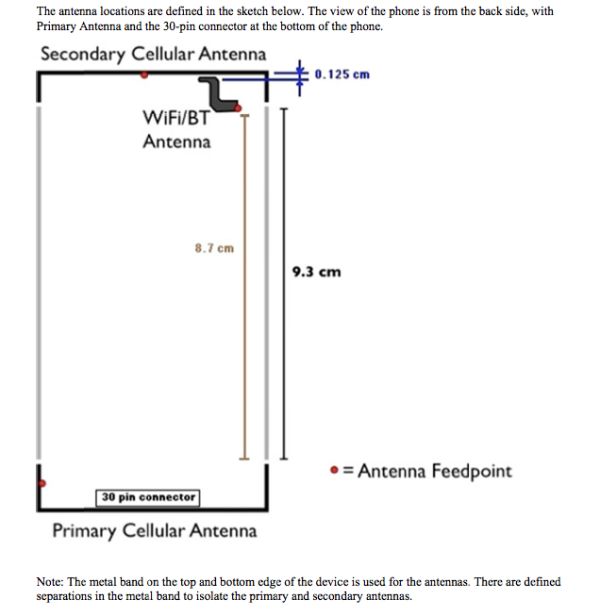
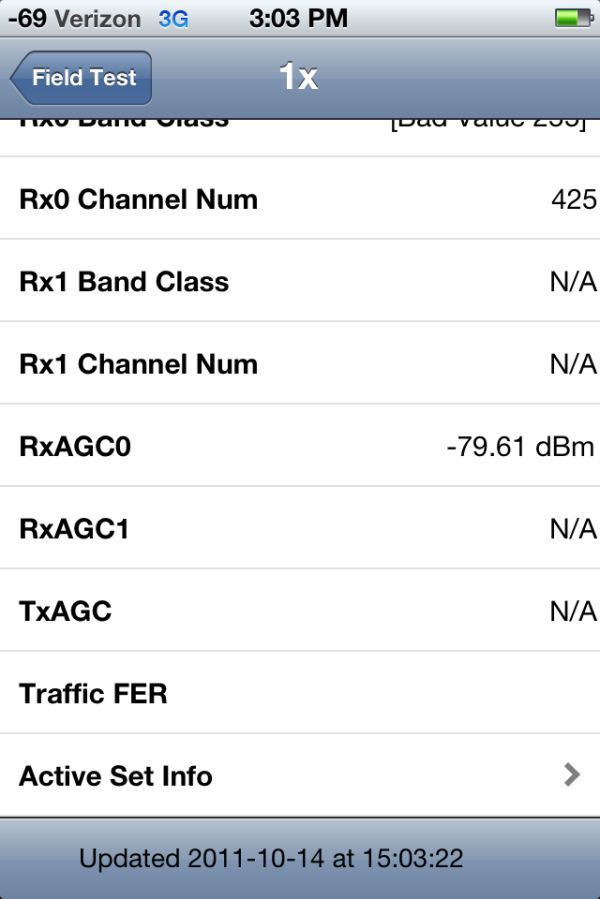
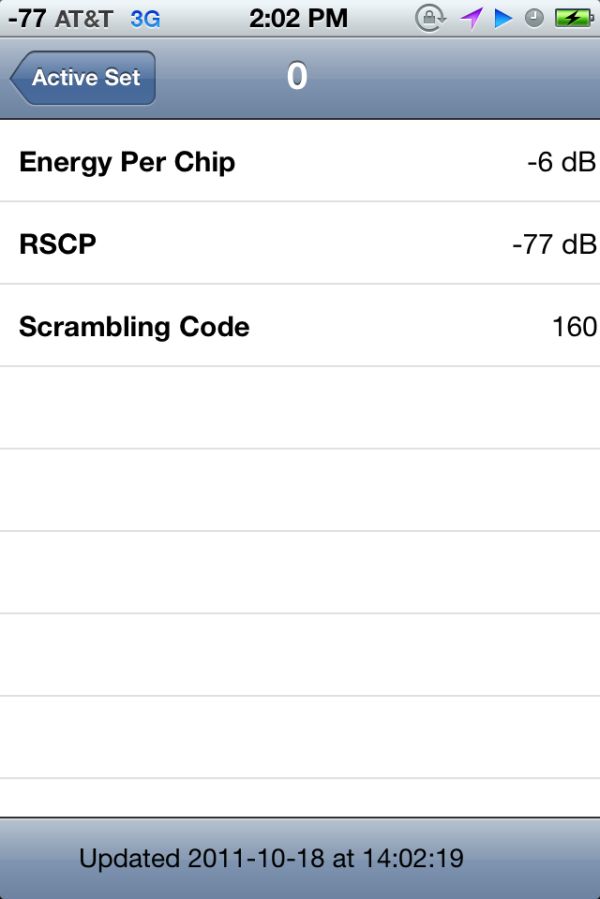








199 Comments
View All Comments
Pata - Tuesday, November 1, 2011 - link
Will these factors (bluetooth and gps) be incorporated in future tests? I now keep bluetooth and the gps on for Siri and geofenced reminders. I'm guessing that Android phone users might be soon be using bluetooth more often as well, given all the bluetooth watch accessories that will soon be available for their platform. With bluetooth and gps left on, with find my friends, reminders all running in the background, my iPhone usually doesn't last anywhere up to 9 hrs of usage.DukeN - Tuesday, November 1, 2011 - link
Thanks Anand for reviewing every single Apple, iOS, Android/Droid major and minor update since the summer. How about we perhaps devote 2 frickin pages to cover/preview/benchmark some of the newest Blackberry devices?Heck you even covered turds like the HP Veer, and Windows Phone devices.
Perhaps we can devote a couple of pages to the smartphones that have a quarter of the market?
Thanks
jamyryals - Tuesday, November 1, 2011 - link
Even as a [forced] Blackberry user, I'd rather they didn't spend their time reviewing Blackberry devices.Also, it is "biased" in that case.
SicMX - Tuesday, November 1, 2011 - link
Fantastic review, keep up the good work!PS. Especially appreciated the in-depth review regarding the camera + image quality.
Matt Campbell - Tuesday, November 1, 2011 - link
Nice article Brian, Anand. One clarification for Page 8, Siri can't read emails - only incoming (new) text messages. She'll tell you this herself if you ask her to read your emails :)And one comment, the addition of Bluetooth 4.0 is a big leap forward in my opinion. The Bluetooth stack in every other iPhone revision was missing the Serial Port Profile stack, which severely limited hardware developers. Since the 4S is "Bluetooth Smart Ready", it should support all kinds of fun new sensors and gadgets without the need for additional hardware.
_tangent - Tuesday, November 1, 2011 - link
Great in depth review! Anandtech is one of the only places you can find this sort of analysis, and for the technically minded consumer, it's an invaluable resource. Kudos!I'm a bit confused by the GPU arms race in the mobile space. Aren't we reaching a point where the screen is small enough and far enough away from your face that the law of diminishing returns applies? Unless the ultimate objective is to have us all connect our phones to tvs or other displays for gaming on a larger scale.
I'm not sure where i stand on mobile gaming these days. I have a relatively capable android handset, but find myself not even playing the 3D games already available. Not because they aren't good or pretty enough, just because intensive 3d gaming slams my battery, is less well suited to the odd 5 minute opportunity i get to game on the go, and the lack of physical controls for more "conventional" games is often frustrating. In any case, having lived with the handset for 6 months or so, i'm not clamoring for better 3D performance. Maybe plenty of people are though.
I'm not personally a fan of Apple products. Not because they don't offer a great UX and aren't well polished in their own right, but because the cost apparently associated with that is too high. As a software developer by trade I find their draconian, fascist approach to the appstore and development in general somewhat distasteful. I don't equate choice and flexibility with complexity. That said, i don't mind Apple in a world where they have competitors offering an alternative philosophy This drives everyone to innovate which is great for us as consumers.
Hopefully ICS will bring Android up to par with iOS from a UX point of view, whilst retaining the flexibility and customization that much of it's user base has come to appreciate. I look forward to a similarly comprehensive look at the Galaxy Nexus and other ICS phones as they're released!
Shinobi123 - Tuesday, November 1, 2011 - link
Why is the New Razr missing from most of the graphs? It was in the first few, basically the only reason I kept reading this article.. But it wasn't included in any. :(tipoo - Tuesday, November 1, 2011 - link
They probably aren't done testing it.rimshaker - Tuesday, November 1, 2011 - link
As usual, the very best in depth product review available. As a EE, no review is ever thoroughly complete until I read it here on Anandtech. Wonderful!My only question is how to display the numerical wifi RSSI without using 3rd party apps? I tried it in field test mode but the wifi icon never changes like the cell signal does.
dubthedankest - Tuesday, November 1, 2011 - link
I second this question as well as the one prior on how to enable the numerical RSSI for WiFi - that would be very helpful.Great review!